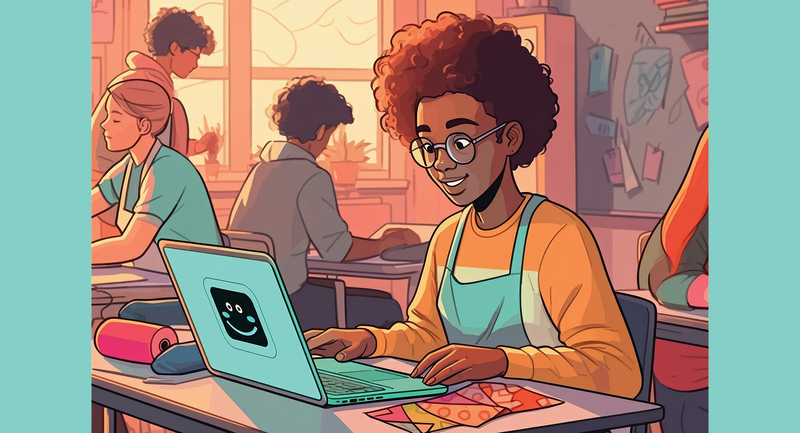Last year toward the end of the semester, I was helping a student in an after-school homework club and asked him how he was doing in his classes. Alejandro told me he was receiving a B in history and a C in math, but that he really didn't have even a good guess about his grades in his four other classes.
I gave him an incredulous glance and asked him to show me his district gradebook and his learning management system (LMS) account. Alejandro opened up his Chromebook and navigated to both his district gradebook and LMS account. Sure enough, we could see all his assignments and even teacher feedback in the LMS, but the final grade function was turned off and individual assignment grades from the LMS did not transfer seamlessly to the district gradebook. When I dug deeper, it appeared that Alejandro's history and math teachers had taken the extra step of entering assignment scores and final grades in both the LMS and the district gradebook, an onerous task when teachers have more than 170 students.
What Is Interoperability—And Why Is It Important?
So, why is Alejandro's experience of not being able to see exactly how he's doing important? Because not knowing how you're doing in a class makes it difficult to know how to improve—and one reason students in some schools can't see how they're doing is the lack of interoperability of tech systems within those schools. That's something school leaders should be able to change. (We could, of course, blame teachers for not double-entering all their grades, but that wouldn't be fair or constructive.)
Interoperability—the ability of different systems to communicate with each other—affects both teacher efficiency and student learning. Technology, when integrated seamlessly, should make teaching and learning resources easier to access for both teachers and students. When it doesn't, everyone suffers. When different learning and gradebook systems can communicate with one another, it reduces the amount of time and effort educators need to spend on administrative tasks; this frees up more time for educators to focus on student learning, which can help improve outcomes. And when learning systems in a school can communicate, students can easily see how they're doing in all their classes and gain a better understanding of their progress.
Another key interoperability issue relates to how students experience learning when they are required to use multiple learning websites and platforms. Sometimes, educators find a great website that requires students to create a user account. That might seem like a simple task. But having students click on a user agreement and provide personal information can be problematic at best and illegal at worst.
The bigger problem, though, is the hurdle students encounter from creating an increasing number of logins and passwords in order to access learning resources. Perhaps one extra username and password isn't overly burdensome, but multiply that by the number of teachers each student has, and it can quickly become overwhelming—and make learning difficult.
Access challenges should not be another thing that pushes students away from learning, collaboration, and creation.
Yes, many students can navigate multiple passwords, but creating barriers for our most vulnerable students who may have already experienced frustrations with technology is indefensible. Access challenges should not be another thing that pushes students away from learning, collaboration, creation, and everything else that a thoughtfully implemented set of edtech tools can offer.
Vetting for Seamless Integration
There is no easy answer to resolving existing interoperability challenges; they often require time, effort, and money to fix. The best course of action is to address interoperability of district systems before software is purchased. As Ben Franklin put it, "An ounce of prevention is worth a pound of cure."
The good news is that districts are increasingly adopting vetting processes for edtech programs that include consideration for rostering. This means that new apps and sites are accepted into the learning environment only if they can be accessed seamlessly when the student logs on using their student account. This single sign-on approach makes navigating between tools easier and allows students to focus on learning rather than access. With this approach, teachers who find an application or education materials platform that they want to purchase and use need to start a conversation with their IT department. They should determine whether the resource in question can be incorporated into the LMS in a way that maintains interoperability and, crucially, respects student privacy.
In addition to a single sign-on environment, districts need to make sure that applications can work seamlessly together. How do applications work within the LMS, and if grading is done online, where are grades entered and where do students see feedback? These types of integration and compatibility questions should be asked near the start of the vetting process, not at the end.
A couple key strategies can help with this process. First, a vendor should be willing to share names and contacts of districts who are currently using their application. Calling current users and asking for their perceptions of the benefits and challenges of the system, as well as specific things you're wondering about, can be invaluable. Second, vendors should allow a trial period to see if the software is truly compatible with your school or district's other systems, such as electronic gradebooks. It might be that your IT department has enough background to make the initial judgement, but doing an actual integration test before purchasing can save a lot of headaches in the future.
A Question of Equity
As for Alejandro, the student in the after-school homework club, we were able to contact his teachers to ask for clarification on how he was doing in class and where he needed to focus. But Alejandro might be the exception to the rule. He was lucky enough to find out about the after-school homework help in the library, he had the motivation to come after a long day, and he had the free time after school to devote to this and the wherewithal to figure out transportation home.
Many students aren't as lucky and are stymied by the lack of interoperability of tech-based systems in schools. Improving interoperability is thus an equity issue. Addressing these challenges will reduce administrative burdens on educators, increase transparency, improve collaboration, and ensure that all students have access to the same deeper-learning resources and opportunities.
Editor's note: This article was originally published, in a different form, on the ISTE Blog.








